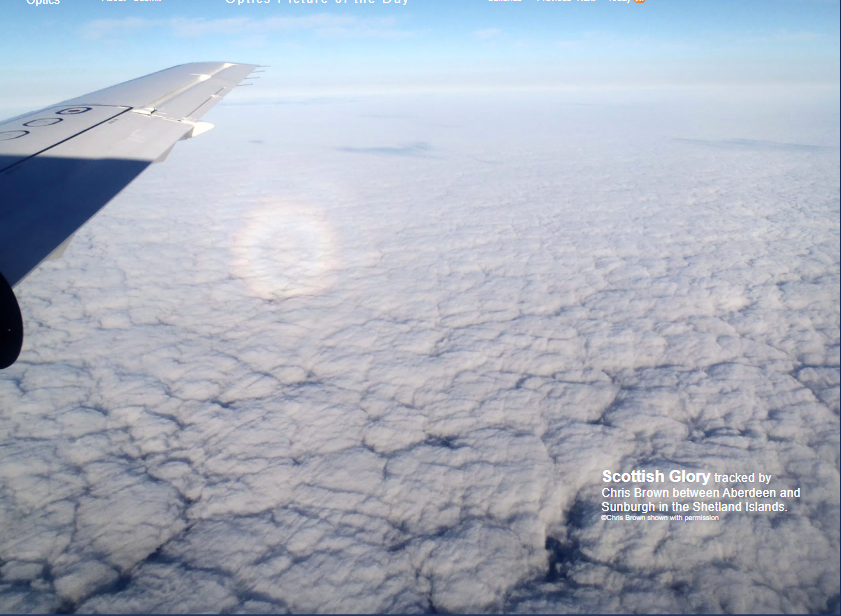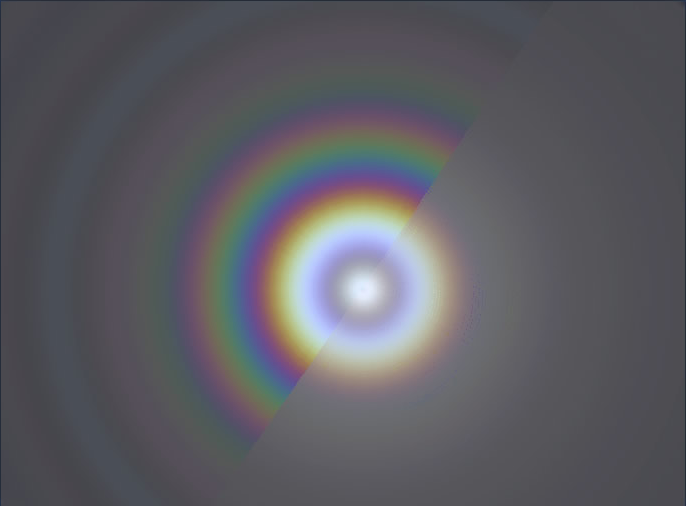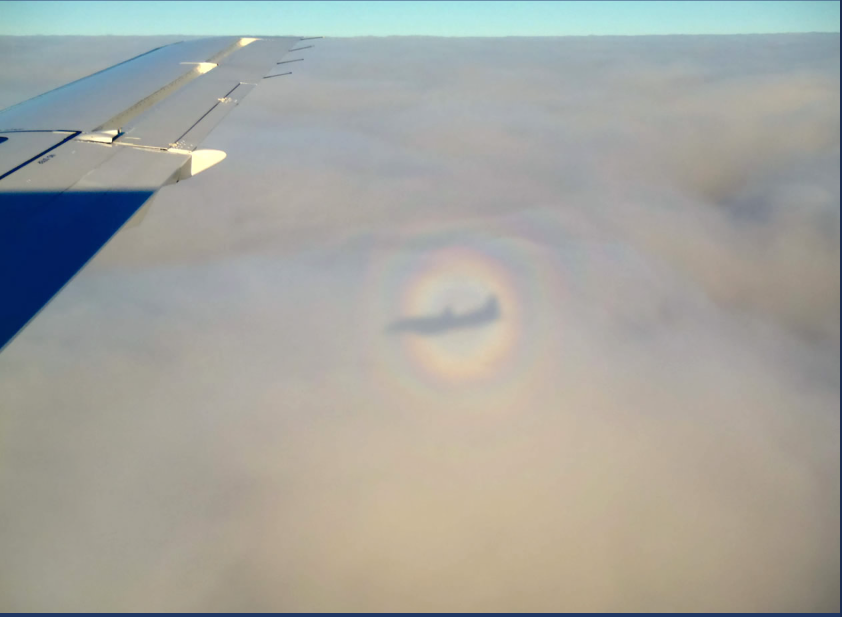OPOD - Glories
OPOD - Glories: A Fascinating Atmospheric Phenomenon
Have you ever looked out of an airplane window and noticed a mesmerizing pattern of concentric colored rings drifting along the clouds? This captivating sight is known as a glory. Glories are diffraction patterns produced by light interacting with small cloud droplets and being scattered almost directly backwards. In this article, we will delve into the intricacies of glories and explore the factors that contribute to their formation.
Glories are not always visible in every cloud deck. They are most pronounced in clouds composed of almost monosized droplets. These droplets produce the best glories, characterized by a dim central glow surrounded by rings that taper off in brightness. The size of the droplets plays a crucial role in determining the glory's structure. Smaller drops give rise to larger glories, while larger drops result in smaller glories.
The inner structure of a glory is a fascinating sight to behold. It consists of a weak central glow surrounded by a brighter ring. The inner part of the ring appears blue, while the outer part exhibits a reddish hue. The colors arise from the interference and diffraction of light waves as they interact with the cloud droplets. The specific arrangement of droplets within the cloud determines the exact colors observed in a glory.
To observe a glory from an aircraft, it is advisable to find a seat on the side opposite to the sun. Once seated, direct your gaze towards the shadow of the aircraft, also known as the antisolar point. Glories can be seen drifting along the clouds, sometimes shrinking or swelling as the airplane moves. Their delicate shimmering pattern adds an ethereal touch to the sky.
Interestingly, depending on the height above the cloud deck, the aircraft's shadow may not always be visible within the glory. As an aircraft descends into a cloud deck, the glory surrounds the position of the camera rather than the aircraft itself. This unique perspective adds a sense of wonder to the phenomenon, as the glory appears to be centered around the observer.
The formation of glories can be understood through Mie theory simulations. These simulations provide insights into the diffraction patterns produced by different cloud droplet sizes. In one half of the simulation, monosized droplets are considered, while in the other half, droplets with a 20% spread around the mean diameter are analyzed. The simulation demonstrates that a range of droplet sizes can smear away the glory structure, as the diffraction pattern is highly dependent on drop size.
In conclusion, glories are a captivating atmospheric phenomenon that adds beauty and intrigue to our skies. Their formation is intricately tied to the interaction of light with small cloud droplets. By understanding the factors that contribute to glory formation, we can appreciate the delicate shimmering patterns and vibrant colors they exhibit. So, the next time you find yourself on an airplane, take a moment to look out the window and marvel at the wonders of a glory drifting along the clouds.

Scottish Glory tracked by Chris Brown between Aberdeen and Sunburgh in the Shetland Islands. ©Chris Brown shown with permission

Find a seat on the side of the aircraft opposite the sun. Search the clouds where the shadow of the aircraft would be – the antisolar point. The glory is a delicate shimmering pattern of concentric coloured rings that drifts along the clouds with the airplane sometimes shrinking or swelling as it does so.
It is a diffraction pattern produced by light interacting with small cloud droplets and being scattered almost directly backwards.
Not all cloud decks produce glories. Almost monosized droplets produce the best with a dim central glow surrounded by rings tapering off in brightness.
At left is a Mie theory simulation of glories computed by IRIS. One half is for monosized droplets, the other for a droplets with a 20% (standard deviation) spread around the mean diameter of the population.
A range of drop sizes smear away the glory structure because the diffraction pattern is drop size dependent – smaller drops give large glories and vica-versa.

Right: The inner glory structure of a weak central glow surrounded by a brighter ring blue on the inside and red outside.
Lower: Depending on height above the cloud deck the aircraft shadow is not always visible. Here the craft approaches the clouds as it descends into the Shetland Isles. The glory surrounds the position of the camera rather than the aircraft.
Right:

Note: this article has been automatically converted from the old site and may not appear as intended. You can find the original article here.
Reference Atmospheric Optics
If you use any of the definitions, information, or data presented on Atmospheric Optics, please copy the link or reference below to properly credit us as the reference source. Thank you!
-
<a href="https://atoptics.co.uk/blog/opod-glories/">OPOD - Glories</a>
-
"OPOD - Glories". Atmospheric Optics. Accessed on November 26, 2024. https://atoptics.co.uk/blog/opod-glories/.
-
"OPOD - Glories". Atmospheric Optics, https://atoptics.co.uk/blog/opod-glories/. Accessed 26 November, 2024
-
OPOD - Glories. Atmospheric Optics. Retrieved from https://atoptics.co.uk/blog/opod-glories/.